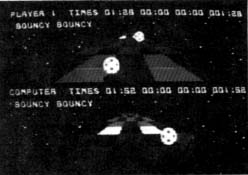TrailBlazer
MINDSCAPE
3444 Dundee Road
Northbrook, IL 60062
48K Disk $29.95
One thing missing in most arcade software is originality. Uniqueness. Although many games display a certain amount of this elusive quality, they usually end up being enhancements; different slants on the same, tired old themes. Rarely does a game break completely new ground, changing the way we play with our computers, like Pong or Pac-Man did. Such a piece of software in the arcade genre is even rarer.

TrailBlazer.
TrailBlazer may not be the next PacMan, in terms of sales, but it is a unique, new arcade game which immediately grabbed my attention-then held it for an extended period. The double-teaming of an addictive quality and a simple concept is a one-two punch that will glue you to your monitor for days.
Envision yourself as a small ball with the ability to speed up, slow down and jump at will. You're on a vast, endless, checkerboard-like racetrack, suspended (somehow) in space. Now, put holes in the racetrack, add special effect squares, and you'll find yourself starting to get the idea behind TrailBlazer.
After booting up, you choose a game to play from a number of one- and two-player options. In the arcade game, you're limited to seven jumps per course, each course having a time limit for completion. Your goal is to complete as many of the courses as you can, racking up the maximum points (points are earned for crossing squares, with additional points awarded for extra time remaining).
A bonus round, like the Simon electronic game, in which you try to remember, then repeat a flashing color sequence, is good for even more points. But it's so hard to reach this bonus round that, after a month. we still hadn't played it.
A trial game allows one person to practice on any of the tracks, while match play pits two players against each other-and the clock-in a no-holds-barred run for the checkered flag. While the latter option was my personal favorite, somewhere in the main menu should be a play option that suits everyone.
Using the joysticks, one or two players compete on a screen split horizontally in half. Control is very simple and easily learned. Forward on the joystick speeds you up; pulling back acts as a brake; left and right perform in a predictable manner. The button makes the ball jump. As you race down the track, a number of squares effect the ball in various ways: black holes swallow you up; red slows you down; green speeds you up; yellow bounces you; and purple reverses your controls. In the arcade version, a flashing square kicks you into warp speed. Yet even with all these features, the true star of this show is graphics.
The displays are crystal clear, the action fast moving, and the control swift and sure. While each player's ball races primarily on one of twin tracks, at times both balls are visible on one display. For instance, as you catch up to your opponent, you can see him in front of you. When he falls into a hole, he'll see you shoot by him on his display. Also notable is the way in which two balls can collide with each other, fighting for position.
Mindscape has adopted the record album style packaging many companies are using today. These are the most space efficient containers I can imagine. Inside you'll find a flippy with the Commodore version on the B side, and a simple and concise manual that completely explains the program's operation and includes control and scoring reference sheets.
I only had a few complaints about the game. While there are twenty-one different courses of varying complexity, which can be combined in groups of three, I would have liked more flexibility in selecting the courses I could play in each of the options. Also, a randomly generated course option, one that would always keep you guessing, would be nice.
I found that the program won't let your ball fall from the side of the track; there's an invisible barrier acting like a guardrail, to protect you from the chasm-a little too safety-minded for me. Often, you have to go through the selection process after each race, making you wait too long to get back on the track. And, finally, high scores weren't saved to disk.
But these are only slight potholes marring the great track record of TrailBlazer. Overall, the game is the most original arcade action wristbuster to come down the pike in a long time, and one of the best two-player competition games I've seen. My main complaint is the severity of the blisters on my hands.